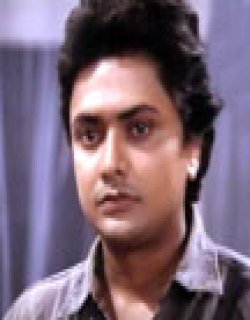

His first movie as a music director was the Bengali film Abhiyatri in 1947. Prior to that, he had recorded the song " Aamaar mallikabone " on All India Radio/Akashvani but, unfortunately, the record has passed into oblivion. The songs were "Aamar Aar Habe Na Deri" and "Keno Pantha E Chanchalata". He recorded his first non-film Rabindra Sangeet disc in 1944 under the Columbia label. His first recorded Rabindra Sangeet was in the Bengali film Priya Bandhabi (1944). Hemanta is considered the foremost exponent of Rabindra Sangeet. followed by Irada (1944 film) in 1944 under Pt. His first Hindi film songs were in Meenakshi in 1942. Hemanta's first compositions for himself were the Bengali non-film songs "Katha Kayonako Shudhu Shono" and "Amar Biraha Akashe Priya" in 1943. Hemanta's first film song was in the Bengali film Rajkumarer Nirbbasan released in 1940 which was composed by S.D.Burman. Music for these songs was composed by Kamal Dasgupta lyrics were by Faiyaz Hashmi. His first Hindi songs were "Kitana Dukh Bhulaya Tumne" and "O Preet Nibhanewali", released in 1940 under GCI's Columbia label. Thereafter, every year Hemanta continued to record non-film discs for the Gramophone Company of India (GCI) till 1984. The songs (non-film) on this disc were "Janite Jadi Go Tumi" and "Balo Go Balo More" whose lyrics were by Naresh Bhattacharya and music was composed by Sailesh Duttagupta. In 1937, Hemanta cut his first gramophone disc under the Columbia label. In an interview on television in the early 1980s, Hemanta had mentioned that he had also received classical music training from Ustad Faiyaz Khan's student Phanibhusan Gangopadhyay, but his tutelage was cut short by the Ustad's untimely death. For this he was nicknamed as "Chhoto Pankaj". In his early life, Hemanta used to follow the famous Bengali singer Pankaj Mullick. The first line of the song was "Amar Ganete Ele Nabarupi Chirantanii." Hemanta's music career was primarily mentored by the Bengali musician, Sailesh Duttagupta. Under the influence of his friend Subhas Mukhopadhyay, Hemanta recorded his first song for All India Radio in 1935. He briefly tried literature and published a short story in the prestigious Bengali magazine called Desh, but by the late 1930s he was committed entirely to music. However, he quit academics to pursue a career in music, despite objections from his father. Īfter passing the intermediate examinations (12th grade), Hemanta joined Bengal Technical Institute at Jadavpur to pursue Engineering. At that time, Hemanta wrote short stories, Santosh Kumar wrote poems and Subhash Mukhopadhyay sang songs. During this time, he developed a friendship with the noted writer Santosh Kumar Ghosh. There he met his longtime friend Subhas Mukhopadhyay who later became a Bengali poet. Hemanta grew up there and attended Nasiruddin School and later Mitra Institution Bhowanipur Branch of Bhawanipore area. They migrated to Kolkata in the early 1900s.

From the paternal side his family originated from Jaynagar. Hemanta was born in Varanasi, in the house of his maternal grandfather who was a leading physician. 11.4 Other languages filmography as a composer.


 0 kommentar(er)
0 kommentar(er)
